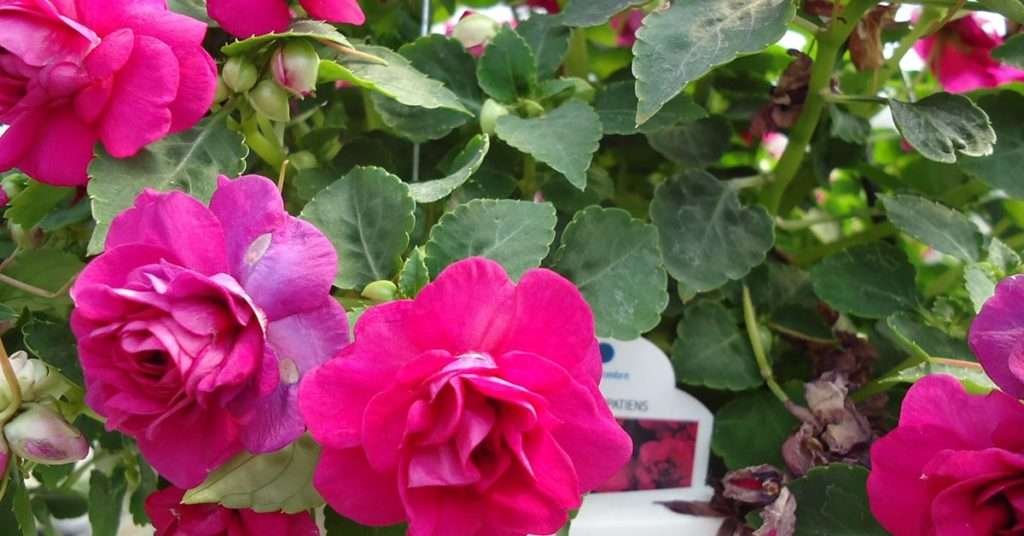“Touch Me Nots”
Everything you need to know about growing and caring for Sunpatiens!

Sunpatiens are exquisite boxy-like flowers that come in vibrant shades of pinks, reds, purples, and whites.
These lovely flowers grace the landscapes of many and fill gardens and outdoor living areas with their charming presence.
Did you know that Sunpatiens are part of the impatiens family, and these flowers are referred to as “Touch Me Nots?” The coined term comes from the exploding seed pod on the plant. When touched, the pod quickly pops open releasing seeds.
Often these pods can fly up to a few feet in the air!
“As an Amazon Associate, I earn from qualifying purchases.”
What are Sunpatiens?

Sunpatiens are a unique series of impatiens that were specifically developed by Sakata Seed of Japan in 2006. Sakata Seed cross-bred two species of impatiens; the New Guinea impatiens and wild impatiens. The goal was to create a species of impatiens that could withstand full sun and warmer climates.
The three-season feature of Sunpatiens provides a landscaped garden a lovely dimension of color and greenery. Leaves of differing greens, bronzes, and variegations add as the backdrop as the vibrant blooms appear in late spring lasting to mid-fall.
| Hardiness Zone | 10-12 |
| Growth Rate | Moderate |
| Sun | Full sun to partial shade |
| Bloom Attributes | Showy 5-petal May – October (continually) Pink, coral, salmon, orange, lilac, lavender, white, purple, red |
| Leaf Attributes | Oval, elliptic leaflets 1-4” Color: dark green, light green, bronze, variegated |
| Fruit | Exploding seed pods |
| Water | Medium |
| Sizes | Compact: 16-30” (height) 14-20” (width) Vigorous: 18-34” (height) 16-21” (width) Spreading: 18-36” (height) 24-36” (width) |
- FALL COLOR: Beautiful hardy mums that are sure to brighten up your Fall garden!
- GROWTH: Mums grow up to about 24" tall with a spread of up to 24".
- CARE: Chrysanthemums will bloom best in full sun. They thrive in well-draining soil and require even, consistent moisture.
- FUN FACT: Mums colors can symbolize different meanings, such as love, sorrow, well wishes, etc., making them a great gift for different occasions!
- LIVE PLANTS: Our plants are grown exclusively for Deep Roots and The Three Company, shipped fresh directly from our greenhouse to you!
Sunpatiens come in one of three series of growth habits.
When you shop for Sunpatiens, you will notice they are sold as compact, vigorous, or spreading. These three things help you to identify how large the plant will become.
Compact Series
- Ideal for small-medium container or hanging basket
- Comes in 24 colors.
- Habit: Compact, upright
- Height: 16-30”
- Width: 14-20”
Vigorous Series
- Ideal for large container, hanging basket, or landscape
- Comes in 14 colors.
- Habit: Upright, mound, spreading
- Height: 18-34”
- Width: 16-21”
Spreading Series
- Ideal for extra-large container, hanging basket, or landscape
- Comes in 5 colors
- Habit: Mound, spreading
- Height: 18-36”
- Width: 24-36”
How to Plant & Propagate Sunpatiens
Propagating Methods for Sunpatiens Cuttings
There are TWO simple methods to propagate a Sunpatien cutting. Use either the soil/media method of the water method. It can take up to a month for roots to develop.
Soil/Media Method
Materials you will need:
- Sharp/sterile knife
- Planting container
- Potting soil/media (you can use either potting soil or soil-free media)
Soil-free media (use a mixture of vermiculite and perlite that is damp; soak in water)
- Grow light
- Place your soil-free media in your container.
- Start with a healthy mother Sunpatien plant.
- Locate the stem that you will cut. It should be:
- Healthy
- Free of any blooms
- 3-6” long
- Have at least 3 leaves.
- Cut your stem (3-6” down) at a 45-degree angle.
- Remove any leaves towards the bottom to allow new root growth.
- Gently place the cutting into the potting soil/media in the container.
- Water thoroughly.
- Place in a warm area under a grow light.
- Continue to mist as needed daily.
- Once roots have developed, you can move to the desired planting site.
Water Method
Materials you will need:
- Sharp/sterile knife
- Jar or vase
- Dow rods to support plant
- Grow light
- Fill your jar/vase with water.
- Start with a healthy mother Sunpatien plant.
- Locate the stem that you will cut. It should be:
- Healthy
- Free of any blooms
- 3-6” long
- Have at least 3 leaves.
- Cut your stem (3-6” down) at a 45-degree angle.
- Remove any leaves towards the bottom to allow new root growth.
- Place dow rods over the top of the jar/vase to support the cutting.
- Gently position the cutting over the jar/vase, ensuring the end is in the water.
- Place in a warm area under a grow light.
- Monitor the water level to make sure the end of the stem cutting is in the water.
- Once roots have developed, you can move to the desired planting site.
Transfer Planting
If you have just purchased Sunpatiens at your local nursery, it’s time to get them transferred into a permanent planter or location in your landscape. It’s quite simple to do this.
To a Container
When transferring to a container or hanging basket, use a good potting soil and a container with holes in the bottom for drainage. Fill your container halfway with potting soil. Gently lift and remove your Sunpatien from the nursery container. Place the Sunpatien in the permanent container and fill with the remaining potting soil. Water thoroughly.
To a Landscape
To transfer to your landscape, be sure to have your planting site prepared.
- Site should not be in an area that floods or retains water.
- Mix a good flower soil mix into the planting site to have a good mixture of earth and flower soil mix.
- Space Sunpatiens at least 16” apart from one another.
- Holes should be about 8” deep and 8” wide.
Gently lift and remove your Sunpatien from the nursery container. Place the Sunpatien in the hole and cover with soil. Water thoroughly.
Growing From Seeds
There are two methods to growing Sunpatiens from seeds. You can either germinate them indoors or plant the seeds directly into the ground outdoors.
Whether you choose to germinate indoors or plant directly outdoors, follow the instructions on the seed packet. Directions will be specific for your particular zone. Regardless of where you plant them, be sure the plants will get ample sun.
Caring for Sunpatiens
Ease of Care
| Level of Maintenance | Low |
| Sun Requirements | Full sun to partial shade Sunpatiens are happy to be in the full sun and do rather well in heat and humidity. Never place them in full shade because they will not thrive. |
| Water Requirements | Medium Water your Sunpatiens early in the day to avoid disease. Damp plants and soil attract not only disease but pests as well. The best way to know if your plant needs to be watered is to watch for a slight wilt. Water thoroughly once you see this indicator. If you do this, your Sunpatiens will develop a robust root system. It also promotes an uptake in calcium – constant watering results in a weak plant structure. |
| Soil Preference | Moist, well-drained |
| Potential Diseases | Bortrytis cinerea (gray mold)Pythium irregulare |
| Potential Pests | Fungus gnatSpider miteThrips |
Diseases and Pests of Sunpatiens
Sunpatiens have an amazing resistance to disease and pests. However, there are rare occasions something could slip through as we will cover below.
Diseases
– Botrytis cinerea (gray mold)
Cause: high humidity and decaying plant matter
Conditions: temperatures 64-77 degrees (F)
Botrytis cinerea is first noticeable by dusty white growths that turn gray. This disease is spread through spores released into the air. It feeds on decaying plant tissue.
– Pythium irregulare
Cause: Soil that is too wet
Conditions: moist
Pythium irregulare is a soilborne disease that causes blight and root rot. It is spread through movement of contaminated water.
Pests
There are three pests that can attack Sunpatiens.
Fungus Gnats:
- Small flies that lay larvae in the soil and potting mixes.
- Larvae destroy plant roots causing stunted growth and death.
Spider Mites
- Oval shaped insects
- Found on the underside of leaves.
- Leaves appear to have yellow speckles, will turn brown and fall off.
Thrips
- Small, slender insects with hairy wings.
- Leaves appear to be scarred, distorted, and spotted.
- Flowers may not bloom if infected.
- Females lay eggs on leaves. The hatched nymphs feed on both the leaves and flowers destroying them.
Management of Disease and Pests
Cultural Control
- Avoid watering plants late in the day. Diseases love moist and damp plants and soil.
- Remove all dead plant matter on the ground and the plant.
- Thoroughly clean all garden tools to prevent spreading disease.
- Space plants apart to allow air circulation.
- Do not water from overhead, instead, water at the base of the plant.
- Don’t overwater plants.
- Do not plant in an area that is prone to retaining water or flooding.
Chemical Control
Use of preventative insecticide, miticides, and fungicides should be applied BEFORE infection happens.
Worthy of Planting!
Sunpatiens are not only beautiful but cheer up the area it is in. You can undoubtedly achieve success by including this colorful gem in your garden or living area. They are easy to grow and maintain.
It goes without saying that if you have not planted Sunpatiens, give them a try. You won’t regret it! They are certainly WORTHY of planting.







